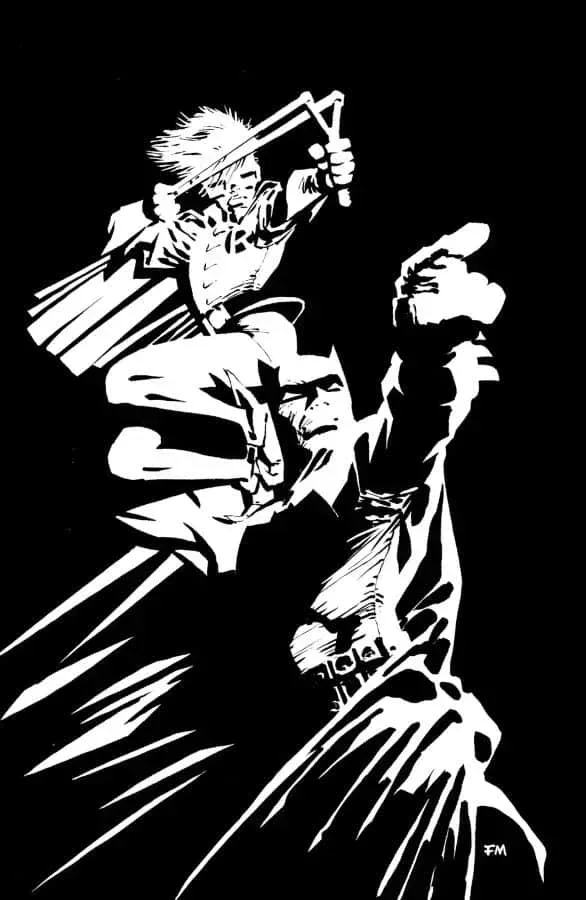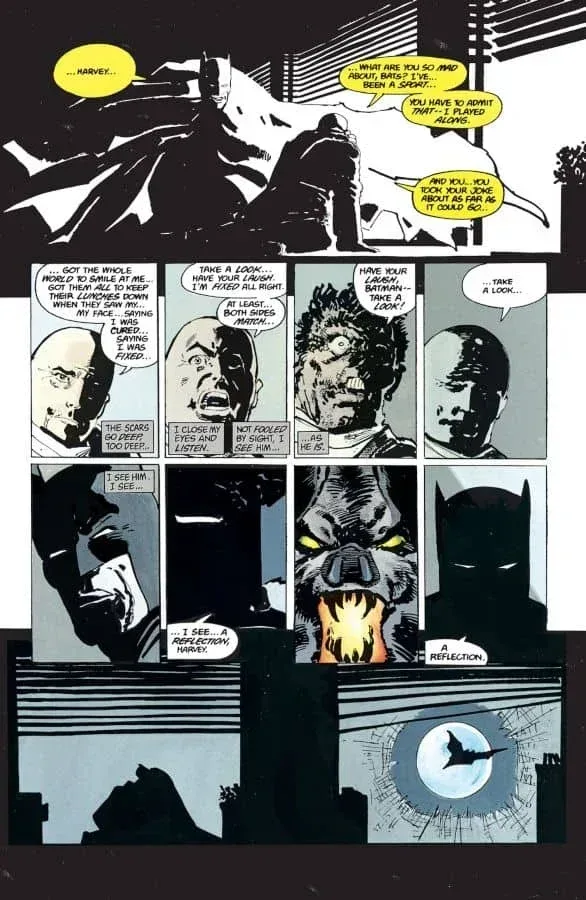
Frank Miller is among the most acclaimed comic book authors ever. Although his bibliography is full of amazing titles, one of his works sticks out and that is The Dark Knight Returns. Published in 1986, The Dark Knight Returns not only redefined Batman, but it also redefined American superhero comic books, pushing them into the Modern Age of Comic Books. What Miller did with this story was lauded by critics, artists and fans, making The Dark Knight Returns not only one of the most important, but also one of the best comic books ever written. Today, I am going to talk about the comic book’s villains.
The Dark Knight Returns has six villains in total. Dr. Wolper is the least relevant among them, followed by a “reformed” Two-Face, with the Mutant Leader and his Mutants, and the Joker being the story’s primary antagonists, alongside Superman, who is not an actual villain, and president Ronald Reagan.
In today’s article, I am going to tell you everything you need to know about the villains of Frank Miller’s The Dark Knight Returns. You are going to find out who these six were and whether they were working independently or for some other villain. Enjoy!
How many villains are there in The Dark Knight Returns?
Before I continue with the detailed analysis of the villains, I think it is important that you know how many of them there were. As far as classic Batman villains are concerned, Miller decided to use two, but that – of course – wasn’t everything. There were also two original villains created for the purposes of this story, as well two unlikely villains – one of them a fictionalized version of an actual historical person, the other one of DC’s most popular heroes.
This all means that The Dark Knight Returns has a total of six villains, although it would be better to use the term antagonists, as they are not really supervillains, not all of them, at least. Also, not all of them have the same importance for the story and in that context, we could say that there are three major and three minor (or even secondary) antagonists in the story. Now, let us continue.
Who are the villains in The Dark Knight Returns?
Now that their number has been established, we can commence with the analysis of Miller’s six antagonists from The Dark Knight Rises. I am going to analyze them in order of significance for the plot and the evolution of Batman’s character, which mostly corresponds to the way they appeared in the story.
The first guy on this list is going to be doctor Bartholomew Wolper. Wolper is a psychiatrist best known as the former therapist of both Two-Face and the Joker. He is a strong opponent of Batman’s vigilantism and blames The Dark Knight for the condition of his villains, claiming that they are all sick, but curable individuals.
Wolper declares Harvey Dent, who had gone through corrective surgery and intensive therapy, sane and releases him from the asylum, after which he takes the city hostage. He later boasts of seemingly having cured the Joker, but ends up being killed by him. Wolper isn’t an antagonist per se, but he presents a strong opposition to Batman and has an obvious political context to him that is a reflection of the political climate of the time.
The same could be said about US President Ronald Reagan, whose fictionalized version appears as the mastermind behind Superman’s clash with Batman. Miller wasn’t a fan of Reagan – he never even tried to hide it in the comic book – portraying the president as despicable and outwardly evil, as a leader who is afraid of Batman because he gives people hope in a time when hope should become a monopolized good. Reagan is also a reflection of the Cold War, just like Wolper’s ideology.
Two-Face, also known as Harvey Dent, is a supporting antagonist and the first of the two members of Batman’s original Rogues Gallery to appear in the comic book. Wolper seemingly cured Dent and released him from the asylum, claiming that the corrective surgery he had been through (that completely fixed his face), in combination with his therapy, cured him.
What he did not know is that the Two-Face persona had completely taken over Dent’s body, unlike earlier, when the two of them had a 50:50 influence over Dent’s body. Two-Face wrapped himself in bandages, now considering his whole face scarred (despite it being healed), and then decided to threaten the city with a bomb as soon as he got released. His plan wasn’t really all that important for the evolution of the plot, but it did have a role in Batman’s return to vigilantism.

The Mutants and their leader, the Mutant Leader, had a major role in the first part of the story as villains and, later, as Batman’s associates, the Sons of Batman. The Mutants weren’t really evil, but rather social outcasts and delinquents no one, society included, cared about. They were just a reflection of the hopelessness of the era and were more like some punk-style version of common street criminals than anything else.
The Mutant Leader was far more dangerous, although he was just the apex of the societal neglect that led to the appearance of the Mutants in the first place. He was a beast and he was a villain, a true threat to Gotham City, and he was the main reason behind Batman’s return to fighting crime.
Superman, although his clash with Batman does – in a way – symbolize the pinnacle of Miller’s story, is still not as important as the Joker, which is why I approach him first. Miller did not portray Superman as a villain here, as some authors did earlier. Superman is still the beloved savior of Earth, but there is a difference now, as he has become a political figure, closely tied to President Reagan.
The clash between Batman and Superman was thus an ideological one, a clash of two heroes that still had a deep respect for each other and that is why Batman spared Superman’s life in the end, faking his own death in the process. He wanted to show Superman that he could defeat him if he wanted and that is what he did; Superman was, of course, aware of his fake death and showed that, despite his political connections, he still retained the heroic values that made him so special.
Finally, the Joker. As it always is with Batman, where there’s a good Batman story, the Joker must be involved in some way. And that’s basically true, and this comic is also proof of that. The Joker went into a catatonic state after Batman’s retirement, as he seemingly lost all purpose in life, seeing how tied he was to Batman and his crime-fighting persona.
When Batman returned, the Joker also snapped out of his state and manipulated his way to a final clash with this beloved rival. Miller really portrayed the mania of the Joker’s twisted mind quite well, much darker than a lot of earlier authors. The importance of Joker’s shattered psyche and the implications of their last fight, which ultimately ends with the Joker’s death, are pivotal in understanding Miller’s Batman, which is why we gave him the biggest role in our analysis.
Are the villains independent of the Joker?
Now that you know the identities of Miller’s six villains, we can answer this article’s final question. As far as their connection to the Joker is concerned, they all acted completely independently of the Clown Prince of Crime but this merits a more detailed explanation.
Now, as far as Dr. Bartholomew Wolper is concerned, he is an opponent of the Batman, whom he labels as a “fascist”, but he is not really working for the Joker or with him, as demonstrated by the fact that Joker brutally murders him later on. Wolper did treat both Two-Face and Joker and is, in that aspect, connected to these guys, but he never worked with them or for them.
Two-Face acted on his own. There was some influence from Wolper, but it wasn’t anything direct and Two-Face acted on his own will. Dent got the certificate, but Two-Face was still present, now fully in charge and completely independent of anyone.
The Mutants acted both on their own and under the orders of the Mutant Leader, but they – as well as their leader – were fully independent and had absolutely nothing to do with the Joker. In fact, when the Joker returned to the scene, they were practically history.
Finally, Superman acted on the orders of President Ronald Reagan but since he appeared on the scene after Joker broke his own neck, there is really no basis to think that either of them worked with or for the Clown Prince of Crime.
And with this, I can conclude the story of Miller’s villains from The Dark Knight Returns.
